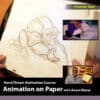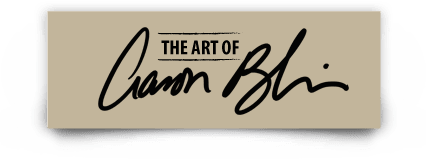Aaron shares why animation on paper is personally meaningful to him and gives you a clear overview of what you’ll learn throughout the course.
Animation on Paper with Aaron Blaise

Lessons
02 Tools and Supplies
Learn about specific supplies for proper registration, preventing jitter during playback, and capturing images. Simple yet effective equipment is key to achieving high-quality animation results.
03 Flipping Paper
Practice paper flipping techniques to improve your animation flow. Learn how in-between drawings add realism and smooth motion.
04 The Bouncing Ball
Aaron teaches you the very first exercise he learned to animate. You’ll learn concepts like squash and stretch, and timing, which help you keep volumes consistent in your animation.
05 The Flour Sack Part 1
Create your flour sack animation with a focus on body attitudes. Learn how to use an exposure sheet.
06 The Flour Sack Part 2
Explore the significance of breaks, key frames, and in-betweens. Key frames and their timing are identified, along with holds and transitions.
07 The Flour Sack Part 3
Bring together everything you’ve learned in the past two lessons to create a complete character animation. Learn practical steps for shooting your frames and editing them
08 Animating a Character Part 1
Build on the teddy bear animation to further explore acting in animation. Refine your thumbnailing, drawing techniques, and deepen your understanding of timing and movement mechanics.
09 Animating a Character Part 2
Explore the animation breakdown process that highlights character movement and timing. Learn the importance of body dynamics to enhance realism.
10 Animating a Character Part 3
Use the key frames from the previous lesson along with your exposure sheet to determine the timing of your animation.
11 Animating a Character Part 4
Explore the drawing process that brings characters to life by focusing on their thoughts and expressions. Learn key techniques like slow ins and outs, arcs, and maintaining visual appeal.
12 Animating a Character Part 5
Continue refining your animation by adjusting timing and adding drawings to create smooth transitions in the Teddy Bear’s movements.
13 Character Part 6 – Completing & Filming the Shot
Complete the Teddy Bear animated sequence. Learn how layering and timing work together to create smooth, expressive animation.
14 Animating Dialogue Part 1
Learn lip sync techniques by visualizing sound waves and exploring traditional methods used to sync sound with animation.
15 Animating Dialogue Part 2
Learn how to reevaluate numbering and adjust timing to strengthen your animation. Focus on refining drawings to favor key poses and create smooth, natural transitions.
16 Animating Dialogue Part 3
Understand the importance of subtle movements and accurate mouth shapes in dialogue scenes. The final test reviews lip sync and overall timing to achieve a polished, professional animation.
17 Final Thoughts
Aaron recaps the key topics covered throughout the course and encourages you to continue practicing and developing your skills in Animation on Paper.
